
As a holistic mom, you strive to provide your children with nourishing and wholesome foods. Snack time doesn't have to be dull or unhealthy! In this blog post, we'll explore creative ways to transform fruits and veggies into fun and delicious treats that your kids will love. Get ready to add a burst of color, flavor, and nutrition to your snack repertoire!
Fruit Fun: Creative Ways to Serve Fruits as Snacks
Discover innovative and fun ways to turn fruits into delightful snacks that your kids will love. From fruit skewers to rainbow fruit salads, make snack time a colorful experience!
Unleashing the Rainbow: Create a vibrant rainbow fruit salad by combining a variety of colorful fruits. Let your kids help assemble the different fruit layers, adding a touch of creativity to their snacking experience.
Fruit Kebabs with a Twist: Make eating fruits exciting by threading bite-sized fruit pieces onto skewers. Encourage your little ones to create their own fruity kebabs, exploring different combinations and patterns.
Silly Fruit Faces: Transform ordinary fruits into whimsical characters by using edible markers or small fruit cutters. Engage your child's imagination while they enjoy a playful and nutritious snack.
Veggie Crunch: Turning Veggies into Tasty Nibbles
Learn how to transform veggies like carrots, cucumbers, and bell peppers into crunchy, nutritious snacks. Explore dips, dressings, and seasoning ideas to make these treats irresistible.
Dippity-Doo Veggies: Pair crunchy veggies like carrot sticks, cucumber slices, and bell pepper strips with homemade dips such as hummus, guacamole, or yogurt-based (use plain greek or coconut yogurt) dressings. The combination of textures and flavors will keep your little ones coming back for more.
Seasoned to Perfection: Add a burst of flavor to your veggie snacks by experimenting with different seasonings and spices. Try sprinkling some nutritional yeast, garlic powder, or even a hint of cinnamon on roasted veggie chips for a delightful twist.
Smoothie Bowl Magic: Healthy and Fun Fruit & Veggie Treats
Dive into the world of smoothie bowls! Learn how to combine fruits, veggies, and toppings to create visually appealing, nutrient-dense treats that your kids will enjoy eating.
Blend and Beautify: Whip up delicious smoothie bowls by blending a variety of fruits, leafy greens, and healthy fats like avocado or nut butter. Top them off with a sprinkle of granola, chia seeds, or fresh fruit for added texture and visual appeal.
Sweet Green Surprise: Introduce your kids to the wonders of green smoothie bowls by adding a handful of spinach or kale to their favorite fruit blend. They'll be delighted by the vibrant color and won't even notice the hidden veggies!
Frozen Delights: Healthy Ice Pops from Fresh Fruits and Veggies
Beat the heat with homemade ice pops! Find out how to use fresh fruits and veggies to create refreshing, healthy frozen treats that are perfect for hot summer days.
Fruit Pop Extravaganza: Blend together your kids' favorite fruits with a splash of coconut water, then pour the mixture into popsicle molds. In just a few hours, you'll have nutritious and refreshing fruit popsicles that beat store-bought options.
Veggie Cool-Down: Experiment with veggie-infused popsicles by incorporating ingredients like cucumber, beetroot, or even sweet potato. The natural sweetness of fruits balances out the flavors, creating a unique and nutritious frozen treat.
Veggie Chips: A Healthy Twist on a Favorite Snack
Discover how to make homemade veggie chips, a healthier alternative to store-bought snacks. Learn about the best vegetables to use and how to season them for maximum flavor.
Baked Goodness: Swap out greasy potato chips with homemade baked veggie chips. Slice vegetables like zucchini, sweet potatoes, or kale into thin pieces, toss them in olive oil, and bake until crispy. These guilt-free chips are packed with nutrients and flavor.
Flavor Explosion: Elevate the taste of your veggie chips by experimenting with different seasonings. Sprinkle them with a combination of sea salt, paprika, or garlic powder, for a savory twist that will keep your kids reaching for more.
Fruity Desserts: Turning Fresh Fruits into Sweet Treats
Satisfy your kids' sweet tooth with desserts made from fresh fruits. Learn how to make fruit parfaits, baked fruit treats, and more that are both delicious and nutritious.
Parfait Paradise: Layer fresh fruits, Greek or coconut yogurt, and granola in a glass to create a tempting fruit parfait. Let your kids customize their parfaits with their favorite fruits and toppings for a delightful and healthy dessert.
Baked Fruit Delights: Experiment with baked fruit treats like apple or pear crisps. Slice the fruits, toss them with a sprinkle of cinnamon and a touch of honey, then bake until they become golden and crispy. Serve them warm with a dollop of Greek or coconut yogurt for a comforting and guilt-free dessert.
Snack time can be both nutritious and exciting by using fruits and veggies as the main ingredients. With these creative ideas, you can transform ordinary produce into fun and delicious treats that your kids will love. So, go ahead and unleash your creativity in the kitchen, and enjoy guilt-free snacking with your little ones!
Have picky eaters? Grab this guide: 7 Strategies to Help Picky Eaters Eat!
My blogs contain some affiliate links.
Any purchase made is a blessing to my family at no extra cost to you!
Thank you for supporting us!


As mothers, we are often the primary caretakers of our families' health. From putting food on the table and caring for our home to bandaging scraped knees or soothing a feverish child in the middle of the night, it's up to us to ensure our loved ones are in good shape physically, mentally, and emotionally. This role is not just about responding to health crises as they arise; it's also about preventing them through proactive measures and instilling healthy habits that will serve our children well throughout their lives.
Recognizing the Role of Moms as Health Advocates
The first step in this process is recognizing our critical role as health advocates. Our actions, attitudes, and decisions significantly impact the overall health and wellness of our families. We set the tone for our family's health culture. By prioritizing health and wellness ourselves, we can inspire our children to do the same. We can do the research and find all the different ways to support our families best. We are also the gatekeepers of our home. We decide what comes through our door: junk food vs whole food, toxin laden products vs clean products, etc.
Teaching Healthy Habits to Kids
One of the most effective ways to promote health within our families is by teaching our children healthy habits from a young age. This includes basic hygiene practices like hand washing and oral care, as well as regular exercise, sufficient sleep, and most important of all, balanced meals. Nutrition provides the foundation for our children's health for their whole lives, and we can help them have a fantastic start! Holistic remedies, such as essential oils, can also play a valuable role in maintaining health and treating minor ailments.
Remember, teaching is more than just telling; it's about showing and doing together. Make these activities fun and engaging – turn hand washing into a game, cook healthy meals together, or go for family walks or bike rides.
Navigating Health Information
In today's digital age, we have a wealth of health information at our fingertips. However, not all sources are reliable or applicable to our unique circumstances. It's essential to discern reliable sources, understand the information presented, and apply it effectively. Consider turning to reputable health organizations, holistic health practitioners, herbalists, aromatherapists, nutritionists, and others with many years of experience in their respective fields and positive results to show. Don't be afraid to ask questions or seek second opinions. Remember, informed decisions are empowered decisions.
Communicating with Healthcare Providers
When it is necessary to visit a healthcare provider, open communication with is crucial. Don't hesitate to ask questions, voice concerns, or share observations. You know your family best, so trust your instincts and advocate for what you believe is in their best interest. Your perspective is invaluable, and a good healthcare provider will appreciate your input and partnership in caring for your family's health. If your healthcare provider will not listen to you or discounts without merit the holistic options you would like to try, you are perfectly free to get a new healthcare provider who is more informed and is willing to work for you. This is a mindset shift I was able to make years ago. Your healthcare provider is not all-knowing, is not your boss, and you can fire them to find a better one who will work for and with you.
Be the Change You Want to See in Your Home
Finally, remember that as a mother, you are a powerful role model. The choices you make, the habits you cultivate, and the attitudes you display toward health and wellness will significantly influence your children. If you want your children to value health, show them what that looks like through your actions. Take responsibility and model what a healthy person eats, does, says, etc. This may take some adjusting, but we are all a work in progress, so do the best you can with the knowledge you have, and always seek to learn more! Let's empower ourselves to be the change we want to see in our homes.
Advocating for family health at home is a multifaceted endeavor. It requires us to recognize our role as health advocates, teach healthy habits, navigate health information, communicate effectively with healthcare providers, and lead by example. It's a challenging task but one that comes with significant rewards. Together, we can raise a generation of children who understand the importance of health and are equipped to take responsibility for their wellbeing.
Have picky eaters? Grab this guide: 7 Strategies to Help Picky Eaters Eat!
My blogs contain some affiliate links.
Any purchase made is a blessing to my family at no extra cost to you!
Thank you for supporting us!

My blogs contain some affiliate links.
Any purchase made is a blessing to my family at no extra cost to you!
Thank you for supporting us!

My blogs contain some affiliate links.
Any purchase made is a blessing to my family at no extra cost to you!
Thank you for supporting us!


Motherhood is a full-time job, and moms often find themselves juggling multiple roles and responsibilities. Despite this, it's possible to do it all and still have the energy to enjoy life. In this blog post, we'll explore four key things that can help moms maintain their energy levels and live a balanced life: sleep, eating well, NingXia Red, and exercise and add some practical daily tips.
Sleep: The Foundation of Energy
Sleep is a crucial aspect of maintaining energy levels, but we understand that getting enough rest can be challenging for moms, especially those with infants. While it may be difficult to get a full night's sleep, there are steps you can take to improve the quality of your rest:
- Create a relaxing bedtime routine to signal your body that it's time to wind down.
- Keep your bedroom cool, dark, and quiet to create an optimal sleep environment.
- Take short naps during the day when possible, even if it's just 20-30 minutes.
- Share nighttime duties with your spouse or ask for help from family and friends.
Eating Well: Fueling Your Body
A balanced diet is essential for maintaining energy levels throughout the day. Focus on consuming nutrient-dense foods that provide sustained energy, such as whole grains, lean or plant-based proteins, healthy fats, and plenty of fruits and vegetables. Here are some tips for eating well as a busy mom:
- Plan your meals in advance to ensure you always have nutritious options on hand.
- Keep healthy snacks like nuts, seeds, and fresh fruits & veggies readily available.
- Consider meal prepping to save time and reduce stress during the week.
- Stay hydrated by drinking water throughout the day.
- Stay away from energy drinks, caffeine, and processed foods.
NingXia Red: A Nutrient-Packed Boost
NingXia Red is a powerful antioxidant drink made from wolfberries, essential oils, and other nutrient-rich ingredients. This natural supplement can support overall health and wellness while providing a much-needed energy boost. By incorporating NingXia Red into your daily routine, you can experience increased vitality and improved mental clarity. I found this when I was pregnant with my 7th child and had been dragging all day, and falling asleep at the dinner table every night. The very first day, I did not fall asleep early and I felt the benefits throughout my pregnancy, through labor and delivery, and breastfeeding, and I kept right on going - I have been drinking it since 2012. I still feel the benefits!
Exercise: Energizing Your Body and Mind
Regular physical activity is essential for maintaining energy levels and promoting overall well-being. Aim for at least 30 minutes of moderate exercise most days of the week. This can include activities like brisk walking, swimming, or yoga. Exercise not only helps to increase energy but also reduces stress and improves mood. Here are some tips for incorporating exercise into your busy schedule:
- Break up your workouts into shorter sessions throughout the day. 10 minute workouts can do amazing things!
- Involve your kids in your exercise routine, like going for family walks or bike rides.
- Choose activities that you enjoy and look forward to doing. I love dancing, so zumba and bar classes are my favorites!
Practical Daily Tips for Maintaining Energy
Finally, here are some helpful daily tips for managing your energy levels as a busy mom:
- Prioritize tasks the night before and focus on accomplishing the most important items first.
- Delegate responsibilities to your spouse or older children when possible.
- Set aside time for self-care, such as reading, journaling, or taking a relaxing bath - or even just take a long "break in the restroom." Ask for support from your spouse, friends, and family for this.
- Practice mindfulness and deep breathing exercises to help reduce stress and maintain focus.
- Use essential oils that support your adrenals or help you be alert.
While motherhood can be demanding, it's possible for moms to do it all and still have the energy to enjoy life. By focusing on sleep, eating well, incorporating NingXia Red, exercising regularly, and implementing practical daily tips, you can maintain your energy levels and live a balanced, fulfilling life as a mom. Remember to be patient with yourself and celebrate your accomplishments – you're doing an amazing job!
***If you need a supportive community and have health goals that include more energy, less stress, better sleep, lowering inflammation, or losing weight, check out the Jumpstart.
My blogs contain some affiliate links.
Any purchase made is a blessing to my family at no extra cost to you!
Thank you for supporting us!



